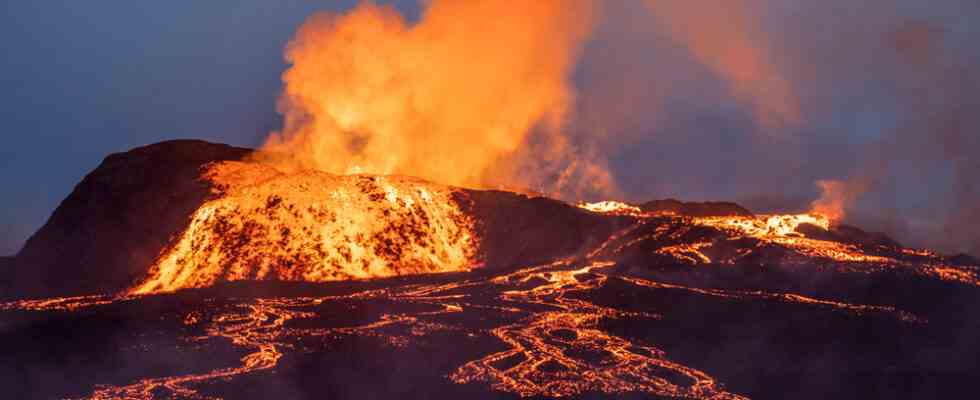Surprising change: The Fagradalsfjall volcano in Iceland not only amazes with its suddenly renewed activity – its behavior is also unique in the world. Because its lava composition changed over the course of a few weeks so radically and quickly as never before observed in an eruption, as volcanologists report in “Nature”. This sheds a whole new light on underground magma flows and volcanic “supply lines”.
According to conventional wisdom, a volcanic eruption feeds itself from the magma chamber of the Fire Mountain: When this reservoir in the earth’s crust fills and the pressure from magma and volcanic gases increases, the volcanic material makes its way to the surface – the volcano erupts. It will take thousands of years for the magma in this subterranean chamber to cool, partially crystallized and mixes with the incoming magma.
When the volcano erupts, the magma chamber empties and feeds the lava flows emerging on the surface. Their chemical composition therefore reflects the conditions in the volcano’s magma chamber and shapes the “chemical signature” typical of each volcano – so it is assumed.
Eruption after 800 years
But the eruption of Fagradalsfjall in southwest Iceland contradicts this scenario, as Sæmundur Halldórsson from the University of Iceland and his team have found. The eruption of Fagradalsfjall began in March 2021, when a fissure opened up in this volcanic area around 40 kilometers south of Reykjavik and glowing lava began to spew out. Some of the lava fountains shot up to 450 meters in the air. It was the first eruption on the Reykjanes Peninsula in around 800 years.
The volcanologists were all the more curious as to what had triggered this eruption and what was happening underground. “To understand what drove the activity, we monitored the chemical composition of the lava, its crystals, and the volcanic gases throughout the eruption,” the researchers report. They took weekly samples of the excavated material.
Amazing change
The result: In the first days of the eruption, the Fagradalsfjall produced lava that was rather low in gas and metal – like most other Icelandic volcanoes. This lava showed the composition expected for magma from a magma chamber about 15 kilometers below the surface. “It corresponds to the long-term average of mantle melts that were stored in the lower crust of the earth,” the volcanologists explain.
But then something surprising happened: Within a few weeks after the start of the eruption, the chemistry of the lava changed drastically: “When we saw the values, it quickly became clear that this new lava was chemically unusual: it belonged to a highly primitive, magnesium-rich type of lava Type we had never seen in Iceland in the entire modern era,” says co-author Eemu Ranta from the University of Iceland.
Worldwide unique observation
Such a rapid and sharp change in lava composition during an eruption came as a surprise to the volcanologists: “In just one month, the Fagradalsfjall eruption showed more chemical variability than the eruptions of the Kilauea volcano in Hawaii in decades,” says co-author Matthew Jackson of the University of California at Santa Barbara. “The Iceland volcano showed rates of change thousands of times higher than Kilauea, where the lava changes minimally even over years.”
And such a strong change is also unusual for Iceland and the volcanic area on Reykjanes: “The range of values measured at Fagradalsfjall only in the first month is just as large as all lava compositions ever measured in southwest Iceland in the last 10,000 years,” says Jackson. Such a rapid, extreme change in the magma chemistry of a hotspot volcano has never been observed in real time.
Direct line into the Earth’s mantle
But what was behind it? As the volcanologists discovered, the chemical change in the Fagradalsfjall lava reflects a radical change in lava replenishment: Instead of “stale” magma from the magma chamber, the volcano increasingly produced fresh magma directly from the earth’s mantle. “The eruption was fed directly from a mantle reservoir without prolonged delays in a shallow zone of the Earth’s crust,” report Halldórsson and his team. It has long been suspected that something like this is possible, but has never been directly observed.
“The Fagradalsfjall eruption demonstrates how quickly a deep magmatic conduit system can reconfigure itself on the fly,” say the volcanologists. The new observations thus provide a unique insight into the hidden processes under volcanic systems. They could also help to improve volcanological models and thus possibly also risk predictions for active volcanic areas. (Nature, 2022; doi: 10.1038/s41586-022-04981-x)
Source: Nature, University of California-Santa Barbara

